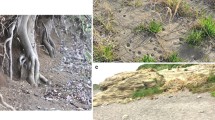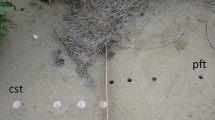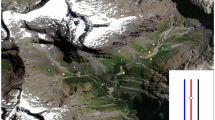Summary
Digging-in effects were recorded while using pitfall traps in a study of ants in Southern Australia. These effects consist of high catches immediately after traps are established which subsequently decline. They are most pronounced among ants with nests close, or accessible to traps, but catches of ants from more distant traps may show delayed digging-in effects. It is suggested that the digging-in effect can be reduced by placing pitfalls, inverted, for one week prior to operating them as traps.
Résumé
Les effets d'enfouissement ont été observés en utilisant des pièges au cours d'une étude des fourmis du Sud australien. Ces effets consistent en de nombreuses captures, aussitôt après la mise en place des pièges, suivis d'une réduction de ce nombre. Ils sont plus marqués chez les fourmis dont les nids sont proches ou accessibles par rapport aux pièges, mais des captures de fourmis dans des pièges plus éloignés peuvent présenter des effets retardés. Il est suggéré que l'effet d'enfouissement peut être réduit en plaçant les trappes renversées une semaine avant de les utiliser comme pièges.
Similar content being viewed by others
References
Brown (W. L.) andTaylor (R. W.), 1970. Hymenoptera, Superfamily Formicoidea.The Insects of Australia, Melbourne. Melbourne University Press, 951–959.
Greenslade (P.) andGreenslade (P. J. M.), 1971. — The use of baits and preservatives in pitfall traps.J. Aust. ent. Soc., 10, 253–260.
Hayes (W. B.), 1970. — The accuracy of pitfall trapping for the sand-beach IsopodTylos punctatus.Ecology, 51, 514–516.
Joosse (E. N. G.), 1965. — Pitfall-trapping as a method for studying surface dwelling Collembola.Z. Morph. Oekol. Tiere, 55, 587–596.
Luff (M. L.), 1968. — Some effects of formalin of the numbers of Coleoptera caught in pitfall traps.Entomologist's mon. Mag., 104, 115–116.
Schaeffer (M.), 1972. — Oekologische Isolation und die Bedeutung des Konkurrenzfactors am Beispiel des Verteilungs musters der Lycosiden einer Küstenlandschaft.Oecologia, 9, 171–202.
Southwood (T. R. E.), 1966. —Ecological methods with particular reference to the study of insect populations. London, Methuen.
Author information
Authors and Affiliations
Rights and permissions
About this article
Cite this article
Greenslade, P.J.M. Sampling ants with pitfall traps: Digging-in effects. Ins. Soc 20, 343–353 (1973). https://doi.org/10.1007/BF02226087
Published:
Issue Date:
DOI: https://doi.org/10.1007/BF02226087




